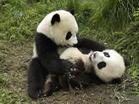
A conceptual proposition (assumed framework) about the ‘fields of struggle’
1. Chinese communalism versus nationhood
· The need to balance multi-racism with local needs
· Commodification of EL v.s. morals of CL
· ‘Privatization of ethnicity responsibilities’ to different racial groups (contribution to nation-building)
· SAP schools despite switch to English as first language in schools
· Historical formation of two ‘factions’ among Chinese Singaporeans
· Sociobiology and politics of race: De-emphasizing dialects through speak mandarin campaign effectively diminishes the roles of communal clans based on dialect groups, though government still appears to be ‘supportive’. Decline of the attraction of Chinese communal societies also reduces their abilities to uphold the ‘ethnic responsibilities’ they were supposed to uphold. Possible mindset: Such clans that are seen to be out-of-step with times may also lead to less attention to ‘ethnicity’ and relegates related values, customs, practices and culture to outdated or obsolete notions in the minds of young parents and children. Chinese language as ‘given’ to a gradual detachment of language competency with ethnicity.
· Talk of Chinese communal spirit but no concrete policies aimed at this, in fact watering down. Strengthening business-related organizations like Chinese Chamber of Commerce
· Apart from values that help businesses, the rest of ethno-cultural heritage is essentially shredded, attenuated or ‘conspicuously hidden or unknown’.
2. Rhetoric about CL: Transferring between forms of capital
· As a cultural capital (though still within the purview of nation-building) to economic rhetoric
· Economic prosperity as the commonplace for overcoming group interests (packaged in terms such as ‘pragmatism’ and ‘meritocracy’, which are subsequently imbibed by Singaporeans into their ‘ways of life’) + Rise of
· Refer to CDA essay on LKY’s parliamentary speech.
3. Mother-tongue language policy and curriculum
*Demarcating the discipline: central content knowledge, foci of learning, connection of ideas, processes to establish new knowledge, validity of claims; connection with students’ thinking; instructional practices
· Compulsory bilingual policy: rhetoric shifting from social harmony to economic globalization
· National curricular materials
§ Retention of ‘national’ agenda e.g. racial harmony (theme & illustration)
· 1991 shared values à ‘5 main themes’ in textbook development; 2004 ‘shared values’ as curriculum framework relaxed
· Curriculum, pedagogy, evaluation
§ Change from first language to second language pedagogy
§ Shift in focus from vocabulary à language skills and thinking skills
§ No emphasis on ‘cultural or ethnic identity’
§ Chinese culture as a ‘static’ pool of resources to be acquired, but often seen as lacking in context and hence relegated or water-downed to inculcation of morals based on Confucianism (dominant learning objectives of anecdotes as ‘acquisitive’ Confucian moral values rather than ‘cultural literacy’)
§ ‘Mainstream’ instead of transformative: Acquisition instead of inquisition;
Apple, M: Hegemony and resistance in curriculum (‘technicality’)
· Stratification and differentiation:
§ Elitism and CL ‘B’-zero sum game
§ Building on the declining and increasingly diverse state of CL competencies, there is greater incorporation of stratification in the form of emphasis on different ‘language skills’. At primary level, weaker students need to only know how to listen and speak, average students to read, better students to write (LKY’s logic). At the secondary level, various forms of streaming, with the freeing up of Higher CL criteria gradually seen as an ‘escapade’ from learning the language at AO level
§ Chinese elites taking curriculum with ambiguity in definition of ‘culture’, who are learning about contemporary
“The tendency of most state curriculum documents is to attempt a set of ‘overlays,’, or grids, that can verify or guide supra-KLA coverage of various ‘core skills,’ ‘values,’ or ‘orientations.’ Hence, we find teachers and schools grappling to grid issues of ‘identity,’ ‘futures,’ and ‘literacy across the curriculum’ across their already atomized syllabi and work programs. What this means is that the soft, less-rationalized skills or knowledge outcomes, becomes part of a subordinate grid of curriculum specification.” (Luke, 2005, p. 22) This eventually leads to dilemmas about educated and formed identities.
4. Educated and formed identities
· A spectrum of concerns:
§ Teachers: Dilemma how to posit their roles in CL education, but generally agreeing that students lack inner motivation and genuine interest
§ Parents: Spectrum from ‘getting out’ mentality (request for abolition of exams) to concerns about declining moral standards that accompany decline in language
§ Students: Rejection of Chinese identity (rare); Hate CL from P1, language competency not seen as an essential part of ethnicity; learning CL as a natural thing but not much room left for possible means of ‘identity-seeking’ and ‘cultural feedback’; no comparison of what it means to be a descendant of a Chinese immigrant, Singaporean Chinese and PRC Chinese that focuses on common roots and substantial differences in thinking modes
· Concerns of the transitory phase
§ Morals and language: Reverse impact of a failed CL planning policy on the beliefs and morals of Chinese Singaporean citizens
§ Difficulties of an integrated code for CL and EL (recognizing ‘language transfer’ but hurdles in mindsets)
§ Effectively diminishing the communal notion in favour of an ‘international perspective’ – even for good students, ethnic identity may not be easily feedbacked
§ Leading to possible other concerns and effects with individualization, immigration (shallow notions of citizenship; ‘us’ v.s. ‘them’ for new immigrants from PRC)
§ Language education policies of tracking that lead to school-mediated forms of privileges (Bourdieu cultural capital)
∴ What does it mean to be Chinese – are there differences culturally and ethnically?Will the complexities of being part of the ‘Chinese Diaspora’ return to haunt Singapore-born Chinese? Is there a fundamental strife between nationhood and communal interests? Are race and ethnicity going to become negligible, if not then how should CL education position itself such that it serves national interests of unity without attenuating cultural knowledge to serve political ends or turned into unpalatable forms of acquired, static, unquestioning propaganda or indoctrination of values? Lastly, and most importantly, what are the identities future Chinese children in
© Tan Wei Xiong, 2009

2 条评论:
what's this?
这就是让那教授看了之后觉得收我为徒的“思考框架”,试图将新加坡华文教育至于广阔的政治社会学背景下,而凸显的是中心问题:个体的民族文化身份困惑。只是想放上来,以后有个参照。
发表评论